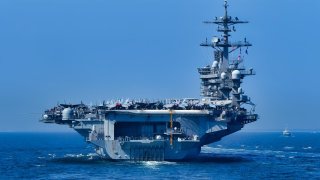The U.S. Navy Almost Built CVV Medium Aircraft Carriers
During the Cold War, the U.S. considered developing medium-sized CVV aircraft carriers as cost-effective alternatives to the larger Nimitz-class, aiming to replace Midway-class carriers within a constrained budget post-Vietnam War.
Summary: During the Cold War, the U.S. considered developing medium-sized CVV aircraft carriers as cost-effective alternatives to the larger Nimitz-class, aiming to replace Midway-class carriers within a constrained budget post-Vietnam War. Supported initially by Presidents Ford and Carter, the plan sought to utilize smaller, cheaper carriers but faced opposition due to the rising popularity of nuclear-powered ships and the economic efficiency of larger carriers. Eventually, the program was discontinued in favor of expanding the Nimitz fleet under President Reagan. Despite the CVV's potential, larger carriers' operational and cost advantages led to the preference for Nimitz-class expansion.
Why Didn’t the U.S. Navy Build Medium-Sized Aircraft Carriers?
During the Cold War, American engineers conceptualized a fleet of medium-sized conventionally powered aircraft carriers. The Aircraft Carrier (Medium) (CVV) design proposed a cheaper alternative to Nimitz-class ships. The program also intended to replace existing Midway-class carriers.
The administrations of Presidents Gerald Ford and Jimmy Carter supported the mid-sized carrier approach. Ultimately, however, the U.S. Navy decided that its resources would be better allocated to constructing additional Nimitz carriers.
The History of the CVV Medium Aircraft Carrier
The U.S. military was working with a limited budget in the aftermath of the Vietnam War. In order to maintain a sizable fleet, then-Chief of Naval Operations Adm. Elmo Zumwalt crafted a plan to produce smaller, cheaper carriers. Each medium-sized carrier was expected to cost roughly $1.5 billion, far less than the cost of a Nimitz-class carrier at the time. The low cost was enticing, but nuclear-powered ships were gaining popularity around this time, especially in the U.S. Congress. When a fourth Nimitz-class carrier was ordered in the mid-1970s, progress on the CVV project halted. But in a surprising turn of events in late 1976, Ford canceled the order for a fourth Nimitz carrier and instead issued his support for the construction of two CVVs.
When Carter took office in 1977, the CVV plan again changed course. The final conventionally powered large aircraft carrier constructed for the Navy – the USS John F. Kennedy (CVN-67) – cost little more than the CVV prototypes and was considered a more capable platform. Secretary of Defense Harold Brown encouraged the service to pursue a new carrier class derived from the John F. Kennedy, but Carter rejected this notion on the basis that smaller ships with smaller airwings carried lower life-cycle costs.
In Fiscal Year 1981, the election of President Ronald Reagan resulted in an overhaul of naval budgets, the reintroduction of a fourth Nimitz-class ship, and the end of the CVV plan.
Pros and Cons of Medium-Sized Carriers
Large aircraft carriers like the Nimitz-class ships were simply believed to be more cost-effective. As explained by Kyle Mizokami, “One hull with a six-thousand-man crew was cheaper to operate than two hulls that required a total of nine thousand men—but collectively had just as many planes. A single carrier also required only one set of cruisers, destroyers and frigates as escorts. Finally, larger carriers could also generate more air sorties than a smaller carrier, and could operate more and larger aircraft.”
Despite these price differentials, smaller carriers deployed around the world today have exhibited capabilities comparable to those of the U.S. Navy’s 11 supercarriers. For instance, the British Royal Navy’s flagship, the HMS Queen Elizabeth, is similar in size and function to the proposed CVV class. This carrier is still able to operate the most advanced fifth-generation short/vertical takeoff and landing aircraft, including the Lockheed Martin F-35B Lightning II.
About the Author: Maya Carlin
Maya Carlin, National Security Writer with The National Interest, is an analyst with the Center for Security Policy and a former Anna Sobol Levy Fellow at IDC Herzliya in Israel. She has by-lines in many publications, including The National Interest, Jerusalem Post, and Times of Israel. You can follow her on Twitter: @MayaCarlin.


